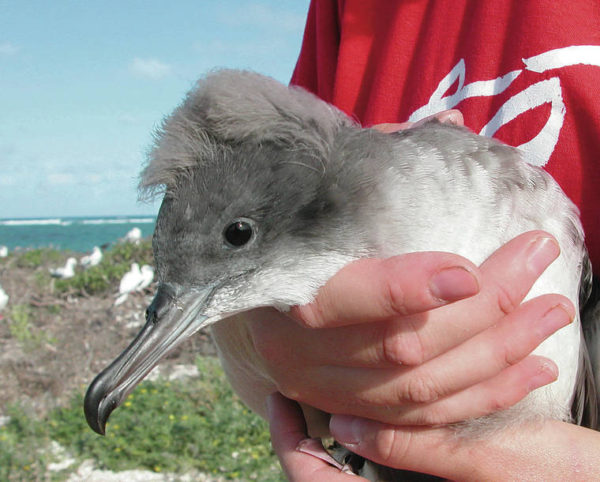Published in the Ocean Watch column, Honolulu Star-Advertiser © Susan Scott
October 19, 2019
If you’ve never seen one of Hawaii’s shearwaters up close, get ready to fall in love. It’s fallout season, and that means some of our fluffy favorites will fall into Hawaii’s homes and hearts.
Fallout season is what seabird specialists call September through December, because that’s when our native shearwater chicks leave their coastal and islet underground burrows at night and head to sea.
 A biologist prepares to put an ID band on this wedge-tailed shearwater
A biologist prepares to put an ID band on this wedge-tailed shearwater
chick’s leg. Hawaii hosts three shearwater species: wedge-tailed (most numerous),
Newell’s (mostly on Kauai) and Christmas (least numerous) shearwaters.
©2019 Susan Scott
Usually guided to the ocean by moonlight, the youngsters raised near human-inhabited islands sometimes mistake land lights for the ocean and fly inland instead of seaward. When the fledglings hit wires, trees and buildings, they fall to the ground lost and exhausted.
Often, downed shearwaters simply need rest and reorientation, and they can then be on their way.
Fallout can happen in all fall months but peaks around the middle on new-moon nights, when moonlight is absent or showing only briefly in slivers. This year that’s Oct. 28-29 and Nov. 26-27, the toughest navigation times for the seabird youngsters, and the days they most need our help.
Shoreside residents can decrease fallout by turning off unnecessary lights, closing curtains over large windows and keeping cats indoors and dogs on leashes.
It’s legal to pick up shearwaters that need saving. But get smitten, not bitten. These usually docile birds might bite when first approached, but often they’re tired and confused, and quickly accept helping hands. If you find a shearwater, follow the guidelines on the delightful 1:45 minute video at bit.ly/358NRj5 by Ilana Nimz of Oikonos Ecosystem Knowledge.
On Oahu, Kailua’s Feather and Fur Animal Hospital takes fallen shearwaters, as does Sea Life Park.
If you don’t want to touch the bird, call Hawaii Wildlife Center or Hawaii Marine Animal Response. Both have workers who will come pick up the bird.
Several websites offer guidance, photos and phone numbers for all islands. Use the search words “seabird fallout.”
Once you meet one of these endearing native seabirds, a fishermen’s favorite because the birds help them locate tuna, you’ll find yourself, like me, in love for life.